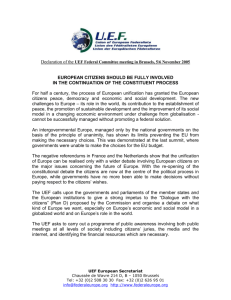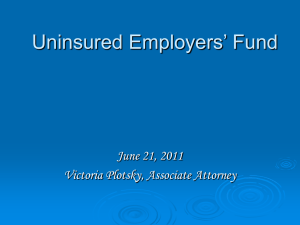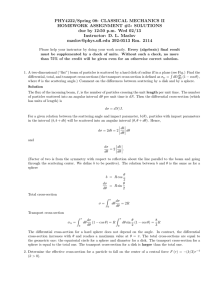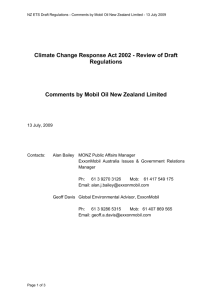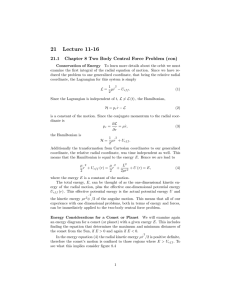(1) PHYSICS 110A : CLASSICAL MECHANICS HW 7 SOLUTIONS Taylor 8.13
advertisement
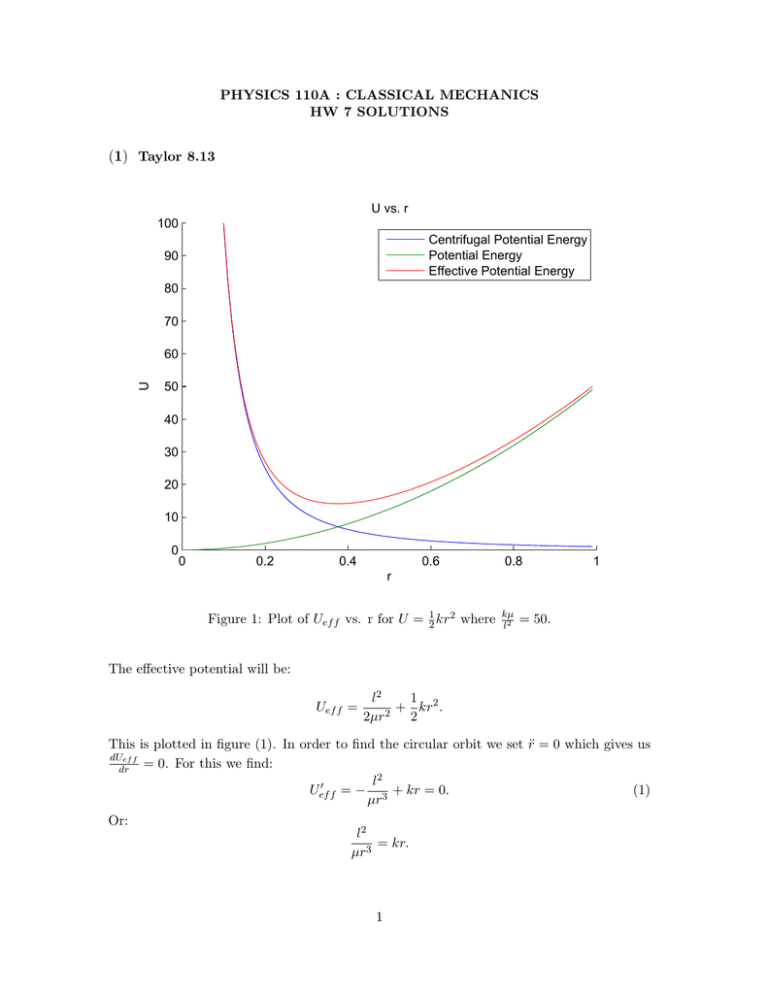
PHYSICS 110A : CLASSICAL MECHANICS HW 7 SOLUTIONS (1) Taylor 8.13 U vs. r 100 Centrifugal Potential Energy Potential Energy Effective Potential Energy 90 80 70 U 60 50 40 30 20 10 0 0 0.2 0.4 0.6 0.8 1 r Figure 1: Plot of Uef f vs. r for U = 21 kr2 where kµ l2 = 50. The effective potential will be: Uef f = l2 1 + kr2 . 2 2µr 2 This is plotted in figure (1). In order to find the circular orbit we set r̈ = 0 which gives us dUef f dr = 0. For this we find: l2 0 Uef = − + kr = 0. (1) f µr3 Or: l2 = kr. µr3 1 Which leads to: s 4 r0 = l2 . µk To find the Taylor expansion we want to find: 1 00 0 2 Uef f (r) = Uef f (r0 ) + Uef f (r0 )(r − r0 ) + Uef f (r0 )(r − r0 ) + ... 2 So we have: Uef f (r0 ) = l2 1 + kr02 . 2 2 2µr0 If we plug in: r02 = √ l . µk We have: s Uef f (r0 ) = k l. µ 0 (r ) = 0, so we need to find the second derivative: By definition (equation 1) Uef f 0 00 Uef f (r0 ) = 3l2 + k. µr04 If we plug in: r04 = l2 . µk We have: 00 Uef f (r0 ) = 4k. So our Taylor expansion is: s Uef f (r) ≈ 1 k l + 4k(r − r0 )2 + ... µ 2 Equation 8.29 in the text gives the equation of motion: µr̈ = − dUef f (r) . dr With this our equation of motion will be: r̈ = − 4k (r − r0 ). µ Which if we take r = r0 + (t) gives us: ¨ = − 2 4k . µ So this leads to a oscillator frequency of: s ω= 4k . µ (2) Taylor 8.14 U vs. r 100 Centrifugal Potential Energy Potential Energy Effective Potential Energy 80 60 40 U 20 0 −20 −40 −60 −80 −100 0 0.2 0.4 0.6 0.8 1 r Figure 2: Plot of Uef f vs. r for U = k r where kµ l2 = −10. The effective potential will be: l2 + krn . 2µr2 This is plotted in figures (1), (2), and (3) for values n = 2, −1, and −3, respectively. (Note: since kn > 0 if n < 0 k < 0 as well). In order to find the circular orbit we set r̈ = 0 which dU gives us dref f = 0. For this we find: Uef f = 0 Uef f =− l2 + nkrn−1 = 0. µr3 3 (2) U vs. r 100 Centrifugal Potential Energy Potential Energy Effective Potential Energy 80 60 40 U 20 0 −20 −40 −60 −80 −100 0 0.2 0.4 0.6 0.8 1 r Figure 3: Plot of Uef f vs. r for U = Or: k r3 where kµ l2 = −0.1. l2 = nkrn−1 . µr3 Which leads to: s r0 = n+2 l2 . nµk To determine which are stable orbits we need a second derivative test. We will have a stable 00 (r ) > 0. equilibrium when Uef f 0 So: 00 Uef f (r0 ) = 3l2 + n(n − 1)kr0n−2 . µr04 Now from above we have: s r0 = n+2 Or: r0n+2 = 4 l2 . nµk l2 . nµk (3) Or: l2 . nµkr04 r0n−2 = Where I divided both sides by r04 . Inserting this into equation (3) we have: 00 Uef f (r0 ) = 3l2 l2 + n(n − 1)k . µr04 nµkr04 Or: 00 Uef f (r0 ) = 3l2 l2 + (n − 1) . µr04 µr04 Or finally: 00 Uef f (r0 ) = (n + 2)l2 . µr04 (4) 00 (r ) > 0 for all n > −2. This is in agreement with our plots. The plots Where we see Uef f 0 of n = 2 and n = −1 have a stable minimum point where the plot of n = −3 does not. We can find the period by finding the angular frequency from the Taylor expansion: 1 00 0 2 Uef f (r) = Uef f (r0 ) + Uef f (r0 )(r − r0 ) + Uef f (r0 )(r − r0 ) + ... 2 with equations (2) and (4) we have: Uef f (r) ≈ Uef f (r0 ) + 1 (n + 2)l2 (r − r0 )2 . 2 µr04 Equation 8.29 in the text gives the equation of motion: µr̈ = − dUef f (r) . dr With this our equation of motion will be: r̈ = − (n + 2)l2 (r − r0 ). µ2 r04 Which if we take r = r0 + (t) gives us: ¨ = − (n + 2)l2 . µ2 r04 So this leads to a oscillator frequency of: √ ω= n + 2l . µr02 5 So we see: 2πµr02 τorb τosc = √ =√ . n + 2l n+2 (Note: check the first sentence of the Professor’s notes in section 9.4.4 for the definition of τorb . An easy way to see this is to note that the time to go around a circle is τorb = 2πr0 v = 2πr0 r0 φ̇ = 2πr0 r0 (`/µr02 ) = 2πµr02 ` where we have used the circumference of the circle divided by the constant tangential speed about the circle (v = rω) to determine the period, or time to circumscribe the circle). Now if √ n + 2 is rational we have: A τosc = . τorb B Where A and B are integers. This implies that the orbit will indeed repeat itself, if we repeat the precessing orbit at least B times, therefore being a closed orbit. (3) Taylor 8.17 If G = r · p then: Ġ = ṙ · p + r · ṗ. We can write this a little different: Ġ = v · p + r · F. Integrating both sides over t we have: Z t Z t dt0 [v · p + r · F] . dt0 Ġ = 0 0 Which can be rewritten as: Z G(t) − G(0) = 2 0 t 01 2 dt mv + 2 Z t dt0 F · r. 0 Dividing both sides by t we have: Z t Z t 1 G(t) − G(0) 0 0 = 2 dt T + dt F · r . t t 0 0 Or: G(t) − G(0) =2<T >+<F·r>. t Then we have: 0 = 2 < T > + < −nkrn−1 r̂ · r > . 6 This is true since G(t) = r · p is always finite, since in a given orbit r has a maximum finite value and p also has a maximum finite value, so r · p is always finite, though oscillating. We can then rewrite this as 0 = 2 < T > −n < krn > . And: 0 = 2 < T > −n < U > . So we have: < T >= n < U > /2. (4) Taylor 8.19 Here we have equations for rmin and rmax for an ellipse: c rmax rmin Figure 4: Figure for 8.19. rmax = c , 1− and: c , 1+ Now remember rmin = 6400 km + 300 km = 6700 km, and rmax = 6400 km + 3000 km = 9400 km. Where 6400 km is the radius of the Earth. rmin = So solving the above two equations for we get = 0.17. At this point it’s easy to plug back in for c = 7802 km. Subtracting the radius of the Earth we get d = 1400 km which is the satellites distance to the surface of the Earth when it crosses the y-axis. (5) Taylor 8.29 By the virial theorem we see that for a circular orbit under the influence of a power law potential U = krn : < T >= −n < U > /2. 7 Which since the gravitational potential has n = 1 our kinetic energy is: T = −U/2. Where I dropped the average sign. So our total energy would be: E = −U0 /2 + U0 . Now if the sun lost half of it’s mass the potential energy would drop by a half, but the kinetic would not change. So we would have: E = −U0 /2 + U0 /2 = 0. We know that for E = 0 we have = 1 and a parabolic orbit, so the earth would eventually leave the sun. (6) Taylor 8.35 This is similar to example 8.6 in the text except run backwards. Initially we have Ri Rf Figure 5: Figure for 8.35. rmax = rmax for the initial circular orbit Ri and the elliptical path which will transfer the craft between circular orbits. Our equation will be: c1 c2 = . 1 − 1 1 − 2 However 1 = 0 because it’s a circular orbit so we have: c1 = c2 . 1 − 2 (5) Now the relation between c constants is: c1 = λ2 c2 . 8 (6) Again this is derived from: v1 = λv2 , and the fact that v ∝ l and l2 ∝ c. Solving for 2 we get: 2 = 1 − λ2 . Now we also want the rmin of this ellipse to match with our final radius Rf . For this to happen we need: c2 c3 = . 1 + 2 Or: Rf = λ2 Ri . 1 + 2 If we plug in our value for 2 we get: s λ= 2Rf = Ri + Rf r 2 . 5 For the second thrust we want to switch from the elliptical orbit into a circular one. So we want to have the same rmin and we will have a relationship between c constants of: c3 = λ02 c2 . (7) So in order to have the same rm in we have: c3 = c2 . 1 + 2 (8) Solving these for the thrust factor we get: 1 = λ= 2 − λ2 r 5 . 8 Similar to the example we use angular momentum to solve for the overall gain in speed: v3 = λ 0 v1 v2 (per) λv1 = . v2 (apo) 2 9
